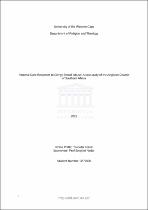| dc.contributor.advisor | Nadar, Sarojini | |
| dc.contributor.author | Koloti, Rhine Phillip Tsobotsi | |
| dc.date.accessioned | 2022-03-23T10:58:02Z | |
| dc.date.available | 2022-03-23T10:58:02Z | |
| dc.date.issued | 2021 | |
| dc.identifier.uri | http://hdl.handle.net/11394/8968 | |
| dc.description | Masters of Art | en_US |
| dc.description.abstract | While media attention seems to suggest that clergy sexual abuse (CSA) occurs primarily in the Roman Catholic church, specifically with children, or in the so-called ‘unregulated’ charismatic churches between charismatic leaders and pious women; the #churchtoo movement suggests otherwise. For example, the multiple cases of clergy sexual abuse from different dioceses in the Anglican Church of Southern Africa (ACSA) which has come to the fore since 2018, indicates how serious the problem is. The prevalent increase in sexual violence is despite the 2002 document called “Pastoral Standards: Practices and procedures for all in ministry” adopted and authorized by the Anglican Church of Southern Africa to provide canonically binding guidelines and detailed processes which ought to be followed where sexual (and other) clergy misconduct is reported. | en_US |
| dc.language.iso | en | en_US |
| dc.publisher | University of Western Cape | en_US |
| dc.subject | Sexual abuse | en_US |
| dc.subject | Feminist pastoral care | en_US |
| dc.subject | Anglican Church of Southern Africa | en_US |
| dc.subject | Abuse | en_US |
| dc.subject | Religion | en_US |
| dc.title | Pastoral care responses to clergy sexual abuse: a case study of the Anglican church of Southern Africa | en_US |
| dc.rights.holder | University of Western Cape | en_US |

